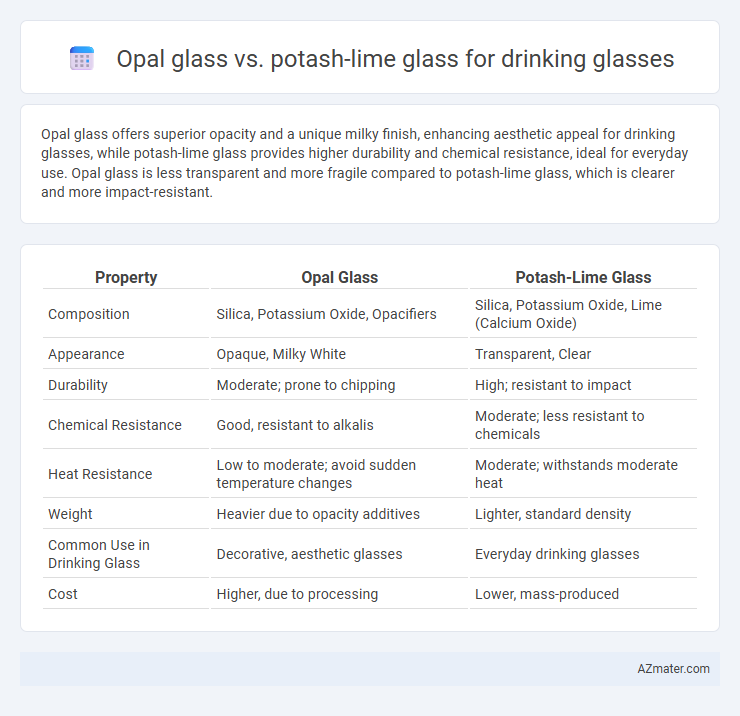Opal glass offers superior opacity and a unique milky finish, enhancing aesthetic appeal for drinking glasses, while potash-lime glass provides higher durability and chemical resistance, ideal for everyday use. Opal glass is less transparent and more fragile compared to potash-lime glass, which is clearer and more impact-resistant.
Table of Comparison
| Property | Opal Glass | Potash-Lime Glass |
|---|---|---|
| Composition | Silica, Potassium Oxide, Opacifiers | Silica, Potassium Oxide, Lime (Calcium Oxide) |
| Appearance | Opaque, Milky White | Transparent, Clear |
| Durability | Moderate; prone to chipping | High; resistant to impact |
| Chemical Resistance | Good, resistant to alkalis | Moderate; less resistant to chemicals |
| Heat Resistance | Low to moderate; avoid sudden temperature changes | Moderate; withstands moderate heat |
| Weight | Heavier due to opacity additives | Lighter, standard density |
| Common Use in Drinking Glass | Decorative, aesthetic glasses | Everyday drinking glasses |
| Cost | Higher, due to processing | Lower, mass-produced |
Introduction to Opal Glass and Potash-Lime Glass
Opal glass is a type of glass characterized by its milky white, opaque appearance, created by adding bone ash or other opacifiers during manufacturing, making it ideal for elegant drinking glasses with a smooth finish. Potash-lime glass, commonly used for everyday drinking glasses, consists primarily of potassium carbonate and lime, offering good chemical durability and clarity at a lower production cost. Both glasses serve distinct purposes, with opal glass preferred for decorative tableware and potash-lime glass favored for practical, affordable drinkware.
Composition and Manufacturing Differences
Opal glass contains a higher concentration of silica and alumina with added opacifiers like bone ash or tin oxide to achieve its characteristic milky appearance, whereas potash-lime glass primarily consists of silica, potash (potassium carbonate), and lime (calcium oxide), resulting in clear and transparent properties. Manufacturing opal glass involves a controlled cooling process and the incorporation of opacifying agents during melting to create its opaque finish, while potash-lime glass uses a simpler melting and forming process aimed at producing lightweight, transparent drinking vessels. These compositional and manufacturing distinctions influence the durability, thermal resistance, and aesthetic qualities of drinking glasses made from each glass type.
Visual Appearance and Aesthetic Qualities
Opal glass offers a distinctive milky-white, translucent appearance that enhances the visual elegance of drinking glasses, providing a soft, diffused glow that highlights beverage colors subtly and attractively. Potash-lime glass, by contrast, delivers a clear, transparent finish with higher brilliance and clarity, emphasizing the liquid's natural hues and reflections for a classic, crystal-like aesthetic. The choice between opal and potash-lime glass depends on whether a muted, sophisticated look or a sparkling, traditional transparency is preferred for drinking glassware.
Durability and Strength Comparison
Opal glass, known for its high opacity and smooth finish, offers moderate durability but is more prone to chipping and cracking compared to potash-lime glass, which is widely recognized for its superior strength and impact resistance. Potash-lime glass contains potassium oxide, enhancing its hardness and making it more suitable for everyday drinking glassware subjected to frequent handling. The chemical composition of potash-lime glass results in greater thermal stability and mechanical resilience, ensuring longer-lasting performance in household and commercial use.
Weight and Handling Experience
Opal glass, known for its dense and opaque composition, is typically heavier than potash-lime glass, which is lighter and more transparent. The increased weight of opal glass can provide a sturdier, more solid feel in hand, enhancing the tactile experience during use. Potash-lime glass offers easier handling and a more delicate touch, making it suitable for everyday drinking glassware where lightweight convenience is preferred.
Safety and Chemical Resistance
Opal glass offers superior chemical resistance compared to potash-lime glass, making it less prone to leaching or reacting with acidic beverages, which ensures safer drinking over time. Potash-lime glass, while more affordable, is more susceptible to surface degradation and potential leaching when exposed to harsh chemicals or prolonged contact with liquids. For applications demanding enhanced safety and durability in drinking glasses, opal glass provides a more reliable and inert option.
Thermal Insulation and Temperature Resistance
Opal glass offers superior thermal insulation compared to potash-lime glass, making it more effective at maintaining beverage temperature over time. Potash-lime glass typically has lower temperature resistance, withstanding heat up to around 150degC, whereas opal glass can tolerate higher thermal stresses due to its unique composition. This enhanced temperature resistance makes opal glass more suitable for hot beverages and scenarios involving rapid temperature changes.
Environmental Impact and Recyclability
Opal glass, composed primarily of silica, alumina, and alkali oxides, offers superior recyclability due to its homogeneous composition and lower energy requirements during recycling compared to potash-lime glass, which contains higher levels of potassium oxide and calcium oxide. The production of potash-lime glass typically consumes more raw materials and generates greater CO2 emissions, exacerbating its environmental footprint relative to opal glass. Opal glass's recyclability and reduced environmental impact make it a more sustainable option for drinking glass applications.
Cost and Availability for Consumers
Opal glass drinking vessels generally come at a higher cost due to their specialized manufacturing process and limited production scale, making them less readily available in mainstream markets. Potash-lime glass, being one of the most common types of glass used for everyday drinkware, is significantly more affordable and widely accessible to consumers through various retail channels. The cost-effectiveness and widespread distribution of potash-lime glass make it a preferred choice for budget-conscious buyers seeking functional and durable drinking glasses.
Best Uses: Choosing the Right Glass for Drinking
Opal glass offers a distinctive, opaque finish ideal for decorative drinking glassware and insulated beverage containers due to its durability and aesthetic appeal. Potash-lime glass, known for its clarity and resistance to thermal shock, is best suited for everyday drinking glasses and drinkware requiring transparency and strength. Selecting between opal and potash-lime glass depends on the desired appearance, durability, and practical use of the drinking vessel.

Infographic: Opal glass vs Potash-lime glass for Drinking glass
 azmater.com
azmater.com